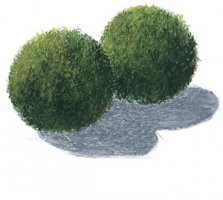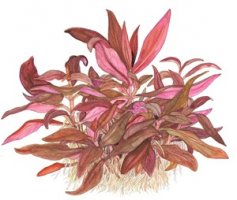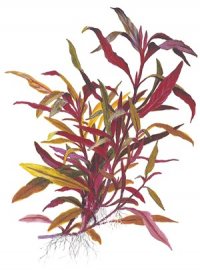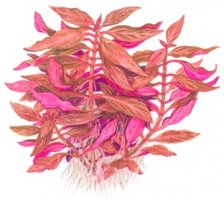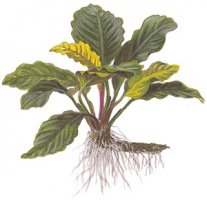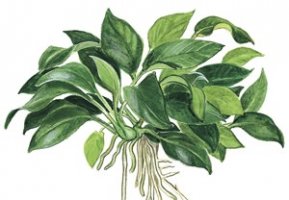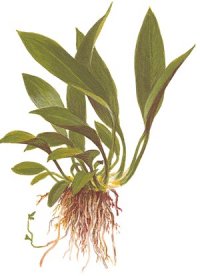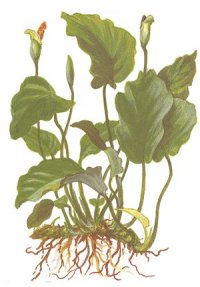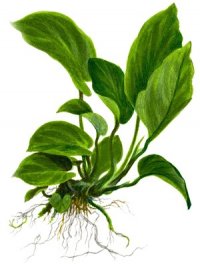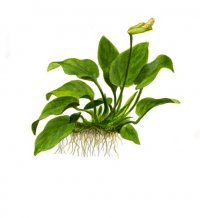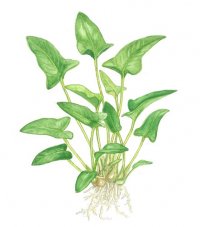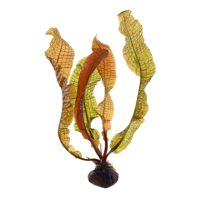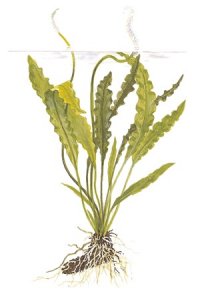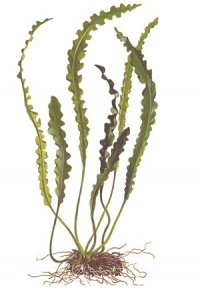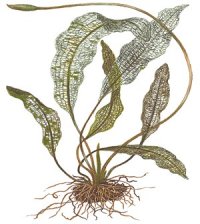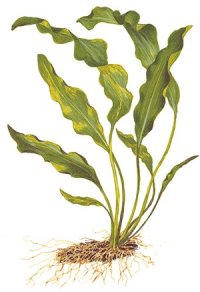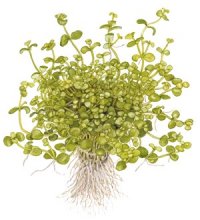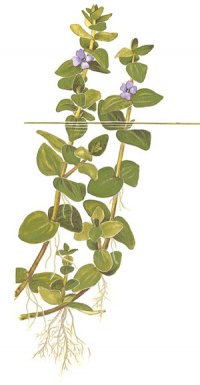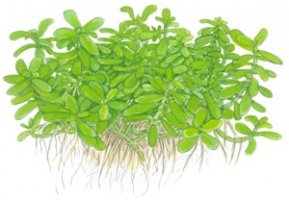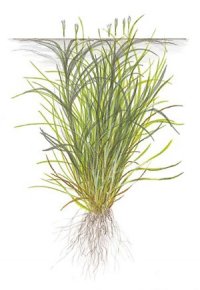-
You are viewing the forum as a Guest, please login (you can use your Facebook, Twitter, Google or Microsoft account to login) or register using this link: Log in or Sign Up
Plantbase
.
Cladophora aegagropila is not really a plant, but a ball of algae from 3-10 cm wide. It is a decorative exception from the rule about avoiding algae at all costs.
It is normally found in shallow lakes, where the movement of the waves forms it into a sphere. In an aquarium it must be turned regularly to keep it in shape. Cladophora aegagrophila can be divided into smaller pieces, which become spherical with time, or which form a carpet, if attached to roots and stones. Protected in parts of...
This miniature version of the well-known Alternanthera is characterized by compact growth and a slower growth rate. It is particularly suitable for small aquariums or as a foreground plant in larger aquascapes. By careful trimming, it is possible to create a dense, red violet carpet of approximately 5 to 10 cm height. High light intensity and addition of CO2 improves the plants growth and overall appearance.
Source: Tropica
The pink underside of the leaves of Alternanthera reineckii 'Pink' provides an effective contrast to the many green plants in an aquarium - particularly when planted in groups. Stems becomes 25-50 cm tall. Good light encourages the leaves to turn red. Easy to propagate by nipping off the terminal bud and planting it in the substrate. This also makes the mother plant more bushy, because more side shoots are formed.
Alternanthera reineckii 'Pink' originated in South America.
Source: Tropica
Vibrant pink leaves with light nerves characterise this vigorous culture form. The plant has a compact form of growth and the stalk does not grow as strong as other Alternanthera. Suitable for planting in the mid-section of the aquarium – and even in the front when cut well. As for all Alternanthera, good light and fertilizer conditions, as well as CO2 additive is material for growth and colour development.
Source: Tropica
Anubias barteri var. coffeefolia is a very beautiful, low cultivar of Anubias barteri. 15-25 cm tall and a creeping rhizome from 10-15 cm or more.
It is characteristic that the leaves arch considerably between the leaf ribs, and the new leaves are red-brown. The colour combination and leaf shape make it an attractive variety in both large and small aquariums. It flowers frequently under water but does not produce seeds there.
Anubias species seem to grow so slowly that they do not realize...
Anubias sp. ‘Petite’ is a mutation which appeared in cultivation at the Oriental aquarium plant nursery in Singapore.
Stays less than 5 cm tall, has very small leaves and a rhizome of 5-10 cm or more from which the leaves will grow. Branches well and creates dense groups. Undemanding like the other Anubias and does not appreciate high light intensity either.
It is most decorative when attached to stones or roots, and like other Anubias it should be attached with fishing line until it gains...
Anubias barteri var. angustifolia from West Africa is a beautiful plant with long, narrow leaves.
10-20 cm tall with a rhizome, from which the leaves develop, that grows 10-15 cm or larger. Very easy to grow since it thrives in almost any conditions, although high light intensity should be avoided. Place it instead in shady positions under larger plants. If planted in the bottom, do not cover the rhizome, it tends to rot. It is not eaten by herbivorous fish.
Anubias barteri var...
Anubias barteri var. barteri from West Africa is an undemanding plant. It grows somewhat larger than Anubias barteri var. nana but is grown in the same conditions. From 25-45 cm tall and the creeping rhizome from 10-15 cm or more. Anubias barteri varies considerably in terms of size and leaf shape.
Like other Anubias-species, it is best planted in a shady spot to minimize algae growth on the leaves. If planted on the bottom, the rhizome must not be covered because it tends to rot. It is...
Anubias barteri var. caladiifolia originates from an Australian tissue propagation laboratory. It is a very beautiful variety with heart-shaped leaves. The leaves live for several years, so Anubias barteri var. caladiifolia can easily form large groups despite its slow growth. A group of Anubias barteri var. caladiifolia growing more than 50 cm wide in a few years is not unusual.
Source: Tropica
Anubias barteri var. nana is a small, attractive plant which thrives in all conditions.
It originates from Cameroon and will reach 5-10 cm height. The rhizome will be 10-15 cm or more. It grows slowly, and the leaves survive for several years, giving slow-growing algae the chance to become established.
The best result is achieved by planting on a stone or tree root. Fishing line can be used to attach the plant until it gains a hold. If planted on the bottom the rhizome must not be covered...
Western Africa is home to several species of Anubias, including this one.
The triangular leaves of 5-10 cm on long leaf-stems make Anubias gracilis one of the most elegant. It is hardy and tolerant, a very good beginner’s plant. The plant can grow on rock or wood or planted on the bottom. If planted in the bottom, the rhizome, from which leaves and roots appear, must not be covered. If it is, the whole plant will rot and die.
Anubias gracilis can be allowed to grow out of the water, but...
Aponogeton boivinianus is a large, strong plant which is only suitable for large aquariums.
A bulb plant from Madagascar, whose bulb may be covered with the bottom layer, as long as the sprout tip is at the soil surface. In favourable conditions it can form very large leaves (up to 80 cm long and 8 cm wide, and from 30-50 cm wide). The oldest leaves are deep dark-green, while younger leaves are light-green and sometimes brownish until they are fully developed. Nutrition capsules enhances...
Aponogeton crispus from Sri Lanka looks great in any aquarium with its light-green, wavy and transparent leaves. Leaves from 25-50 cm and the plant grows to 15-25 cm wide.
It makes few demands, although growth is always best in soft, slightly acidic water with a nutritious bottom. In such conditions the plant produces a mass of leaves, and it flowers very frequently in optimum conditions. Aponogeton crispus is generally found in ponds that are only filled with water in the rainy season, but...
Aponogeton longiplumulosus from Madagascar has large, fluted leaves (35-60 cm long), making it a wonderful plant which can be recommended for large aquariums (the whole plant becomes 25-40 cm wide).
The bulb can be covered with the bottom layer, as long as the sprout tip is at the soil surface. It is relatively undemanding and makes no special demands on water quality. A Nutrition capsule placed under the bulb enhances the growth considerably. It also flowers frequently, making it a...
Aponogeton madagascariensis is a bulb plant from Madagascar and is a speciality in botanical gardens all over the world.
The bulb can be covered with the bottom layer, as long as the sprout tip is at the soil surface. Aponogeton madagascariensis makes such high demands on water quality and the bottom that it can only be recommended as a solitary plant in large, specialised aquariums in which the water is replaced frequently. Nutrition capsules enhances the growth considerably.
There are...
Aponogeton ulvaceus is one of the most beautiful bulb species in the Aponogeton-family and originates from Madagascar.
The leaves are delicate light-green and transparent with fluted margin. A single root can produce more than 40 leaves, 30-60 cm long. This means that the plant is best as a solitary plant in large aquariums (the plant becomes up to 50 cm wide). It is relatively tolerant, and thrives in both soft and hard water, particularly if CO2 is added.
There are many varieties of...
Bacopa australis was discovered in southern Brazil (australis = southern), and it is not from Australia, as might otherwise be assumed from its name. Stems become 10-30 cm tall and 2-4 cm wide. Like the other Bacopa species, Bacopa australis is also easy to grow in an aquarium. Under certain conditions it creeps across the bottom to form an elegant and decorative light green cushion. When Bacopa australis grows in a good light, the leaves become reddish. It is easily propagated by taking...
Bacopa caroliniana originates from US and has been used as an aquarium plant for many years. Stems become 10-30 cm long and 3-4 cm wide, branching willingly from the bottom. It has few demands and thus very convenient for beginners. Its slow growth rate makes it one of the few stem plants that do not need much attention.
Like most stem plants, it is most decorative when planted in small groups. Easy to propagate by cuttings; take a side shoot and plant it in the bottom.
Source: Tropica
This culture form of the stalk plant Bacopa Monnieri is more compact and, under good light conditions, almost a creeping plant. By pinching off all vertical growing shoots, the plant can maintain a low and close growth, since it willingly creates a large number of side shoots.
Furthermore, the plant grows well in the shadow of other plants. Very suitable as a bit higher carpet – or bushy plant in the middle or front of the aquarium. The plant becomes more vertical growing and less compact...
The Blyxa japonica originates in the nutrient rich shallow pools of water, swamps and slowly flowing rivers in East and South East Asia.
The plant has gained notoriety thanks to the late Takashi Amano and his aquarium works from the 90s.
Blyxa has a distinct grass-like appearance that moves easily in the circulating aquarium water creating a sense of dynamicity in comparison to other more robust plants.
Source: Tropica

